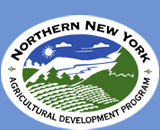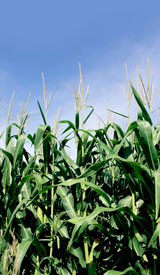July 21, 2009
Contact: Michael E. Hunter, Cornell Cooperative Extension of Jefferson
County, 315-788-8450; and Cornell Cooperative Extension: Clinton County:
518-561-7450; Essex County: 518-962-4810 x409; Franklin County:
518-483-7403; Lewis County: 315-376-5270; St. Lawrence County:
315-379-9192
Can Teff Help Northern NY Farmers as Alternative Forage Crop?
Watertown, NY --- Can a grass native to Ethiopia be a useful or
profitable crop for Northern New York farmers? The Northern New York
Agricultural Development Program and Northeast Sustainable Agriculture
Research and Education Program provided funds to learn the answer.
Agronomy and Field Crops Educator Michael E. Hunter of Cornell
Cooperative Extension (CCE) of Jefferson County is part of a Cornell
University-Cornell Cooperative Extension team that is evaluating the
value of teff, a warm season annual grass.
Hunter co-authored a fact sheet with data on how teff might help farmers
coping with conditions ranging from waterlogged soil to drought.
Research trials were conducted in New York State, including on farms in
Northern New York. Otherwise, teff is grown in the United States on a
limited number of acres in the Pacific Northwest and Midwest.
“In Ethiopia teff is predominantly grown as a cereal crop, not a forage
crop. It can, however, be grown and harvested or as a pasture crop to
feed livestock,” Hunter says.
“Recent research results from teff trials in Jefferson, St. Lawrence and
Rensselaer counties indicate great promise for teff as a forage crop
here,” Hunter says. “Teff has shown it will grow in both wet and dry
conditions. Potential uses here in Northern New York include feeding
teff as emergency hay, pasture or silage planted mid-summer.”
A factsheet titled “Teff as Emergency Forage,” coauthored by Hunter,
Peter Barney (CCE St. Lawrence County), Tom Kilcer (CCE Rensselaer
County), Jerry Cherney (Cornell University), Joe Lawrence (CCE Lewis
County) and Quirine Ketterings (Cornell University Nutrient Management
Spear Program) is posted online at www.nnyagdev.org.
Hunter says teff also has value as a summer annual cover crop to reduce
erosion, as a green manure crop that returns nutrients to farm soils, as
a stand-alone annual hay crop for market, and as a rotational break crop
that helps renovate perennial grass or alfalfa stands or pasture.
“One advantage of teff is that it can be grown using seeding and
harvesting equipment already available to farmers,” Hunter says.
He cautions that teff does not tolerate frost and does not establish
well in cool soils, so planting is best delayed until soil and air
temperatures warm up in June and July.
The fact sheet includes suggestions for seeding and fertilizing rates
and methods and harvest management to obtain a high-quality, high-yield
crop of teff.
“This research has shown us that properly grown and harvested teff can
rival average New York grass hay dry matter yields and produce
relatively high quality forage,” Hunter says.
Crop grower Elmer Dart of Redwood planted a 10-acre field trial for teff
production evaluation in Northern New York in 2006. After harvesting,
Dart said, “The trial yielded a lot more than I expected. It doesn’t
look like there will be much feed until you mow it and put it in a
windrow. I was impressed with the tonnage.”
Hunter cautions that proper establishment of the crop is the first step
toward success with teff.
“First and foremost, I cannot stress enough how important the seedbed
preparation is when growing teff. A firm seedbed is critical and no
different than what we would expect from a grower when they seed
alfalfa,” Hunter says. “I have seen a few mediocre or poor stands of
teff that can be blamed for a fluffy seedbed. A fluffy seedbed is a
recipe for disaster. It is imperative to have a firm seedbed when you
plant teff.”
As part of his evaluation of the teff trial at his farm, Dart said, “The
key to a successful establishment is very good seedbed preparation. This
is so important because the seeds are extremely small. You can’t cut
corners preparing the ground.”
Although a fine-stemmed grass, teff grows into a dense crop and Dart was
concerned about how he would mow the teff for harvest, however, he used
a conventional haybine and had no problems.
In the spring of 2009, dairyman Doug Shelmidine planted a small six-acre
trial of teff at Sheland Farms in Belleville, NY.
“We want to see how teff will grow under our management system and
evaluate it for use as an alternative forage,” Shelmidine says. He will
harvest the teff later this year.
Learn more about growing teff in the Field Crops section at
www.nnyagdev.org. #



